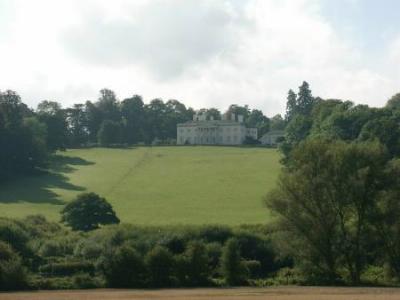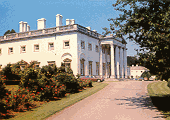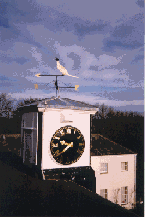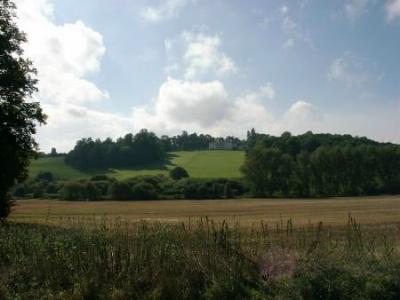
---- News, Views & Information
 |
Amersham ---- News, Views & Information |
On the out skirts of Amersham is Shardeloes.
Shardeloes was the ancestral home of the Tyrwhitt Drake family, the Lord of the Manor.

Shardeloes is a listed building of special architectural
and historic interest, set in 50 acres of grounds and gardens overlooking
a lake and the valley of the Misbourne.
The present mansion was built for William Drake M.P. between 1758 and
1766, mainly designed by Stiff Leadbetter (born 1705) a builder at Eton.
Leadbetter was among the group of architects that responded to changing
fashions in country house use in the 1750s. Thanks to improvements in
roads and carriages, visiting friends in country houses was now an
enjoyable pastime for the upper classes, and was one of the reasons which
led to the development of a new style of house. Instead of the earlier
internal plan with its straight route from the largest to the most
intimate room, where only confidantes of the host were admitted, a
circular route was now preferred; a series of communal rooms for
entertaining, running into one another and circling round the staircase.
Rooms could now be reached from the central core without having to process
through other rooms.
If, however, a client wanted the latest in fashionable decor, Leadbetter
was quite happy for them to employ someone else to finish the house. Mr.
Drake decided to ask the rising architect Robert Adam to improve the plans
both outside and in, and a letter from Leadbetter to William Drake on 13
February 1761 says that he has "delivered the plans of your best rooms
to Mr. Adams and as soon as he has made designs for the ceilings etc.
(which you approve) I will immediately send as many plaisterers as can
be employed".

Picture Courtesy of Bridget Clarke
The house which was finally built is of stuccoed brick
one and a half storeys high, nine bays by seven, with a top balustrade and
giant pedimented portico of stone with Corinthian columns and Corinthian
pilasters against the house wall. The ground floor windows in the end bays
have pediments and are set in shallow niches. The rooms on the ground
floor are eighteen foot high, with immensely thick walls requiring double
doors to the rooms with standing space between. The stone came from
Headington Quarry, and was brought from Oxford to Hedsor Wharf by river.
The Westmoreland slate came up the Thames from London to Eton, costing £3
5s 0d for a consignment of 13 tons, and £6 10s 0d to carry it overland
thence to Amersham. 436,500 common stock bricks at 6s 9d per 1000 were
used, with the large bricks for the front costing 7s 9d per 1000. A
bricklayer was paid 2s 8d per day and a labourer 1s 2d. The total cost of
the house in 1766 was £19,129 19s 4d. Luckily, Mr. Drake was one of the
wealthiest commoners in England.
Internally, Adam was responsible for the decoration and plaster work of
the main hall, the drawing room, dining room, library and boudoir (the
last two with later additions by architect James Wyatt). Famous craftsmen
were employed, Joseph Rose for plaster work, Alken and Lawrence for wood
carving and Thomas and Benjamin Carter for fireplaces, but not all the
workmen were famous and the town of Amersham provided many; Henry
Woodbridge with "young Shrimpton" did carpentry work; John King,
blacksmith, Isaac Wheeler, brazier, and Roger Cutler, plumber, were all
local, as was William Ayres who made many of the common stock bricks. The
£7 3s 0d paid to Amersham turner's worker Mr. John Read included £1, 12s
0d for the staircase bannister.
The Drake & Tyrwhitt Drake family were the Lord of the Manor and had a
great influence on Amersham. By marrying well their fortunes grew through
the 16th to 19th centuries. The Tyrwhitt Drakes were also benefactors and
built the Market Hall and Alms Houses in Old Amersham. The family's
fortunes declined in the 19th and 20th centuries, high death duties was
one of the reasons when much of their property in Amersham was auctioned
off in the 1930s in what became known as the auction of a town. Shardeloes
was requisitioned as a maternity home at the outbreak of war and by 1945
there was no hope of recreating the way of life that had existed for
hundreds of years on the estate. Uninhabited and neglected by 1953
Shardeloes was bought by a property company headed by Sir Ian McTaggart,
hoping to demolish the house and redevelop the site. The newly formed
Amersham Society, with help from the Council for the Protection of Rural
England and other interested bodies, fought a long battle until a
preservation order was put on the building preventing its demolition.
The house was restored and converted into flats and houses, which were
first rented and then sold in the 1970s. Three further flats in the upper
floor in the roof (previously servants quarters) were constructed but no
windows were allowed on the front and east side, though some were allowed
on the rear side and the side overlooking the stable block. A small roof
garden was permitted at the front, though hidden from view. The new owners
(who shared the freehold) had a general wish that everything possible
should be done to restore the house and surroundings to their original
beauty. The stable clock was restored for the Millennium.

Picture Courtesy of Bridget Clarke
The grounds and the park, including the outstanding views
of hills, woods and copses across the Misbourne valley, were laid out by
landscape architect Humphrey Repton in 1793, utilising elements of the
earlier landscaped grounds. In 1987 the garden was listed as Grade II*
(the house had many years earlier been listed as Grade I). In March 1990
Shardeloes was judged to be of Outstanding Historic Interest by the
Gardens Committee of English Heritage.
Repton described Shardeloes as "one of the most beautiful situations in
England" and quoted with approval Edmund Burke’s description of the house
as a "perfect specimen of elegant English residence."

Any additions, corrections, alterations, please email
the web master
Share your views on Amersham, or post a message for others to read on
the Amersham forum
Amersham Home Page
 |
Amersham ---- News, Views & Information |
This web site is Copyright
and operates a privacy
policy
please also see disclaimer